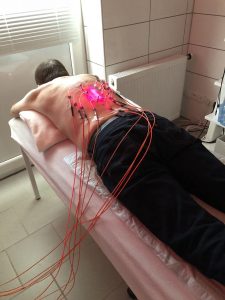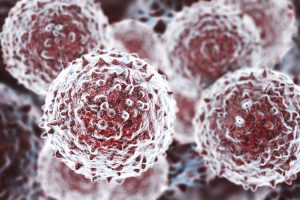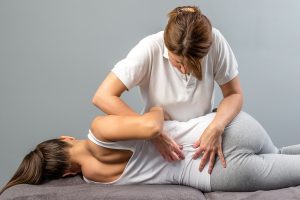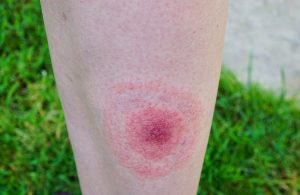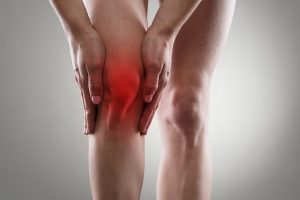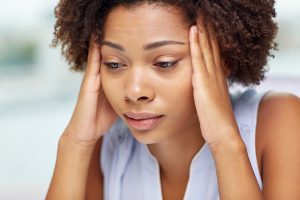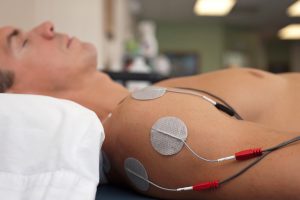Low-dose laser activated stem cell therapy is a treatment solution for those with degenerative joint disease. Degenerative joint disease or osteoarthritis typically affects the major joints like the knees or the hips. Low-dose laser can activate stem cells. In doing so this therapy can also offer a solution for those with chronic back pain due to degenerative changes in the discs or facet joints.
Osteoarthritis in the spine
Last year my family doctor diagnosed osteoarthritic changes in the discs and facet joints of my lower back. I visited Dr. Weber in Germany and he treated me with low-dose laser activated stem cell therapy in November 2017. A prior blog explained the details of this treatment.
New symptoms of back pain in the thoracic spine
During the spring and summer of 2018 I noted that there was some residual back pain in my dorsal spine (also known as thoracic spine). This was just above the previously treated back pain, which had been fine since November 2017. My family doctor arranged for an MRI scan of the thoracic spine confirming moderately severe degenerative changes in the discs and facet joints of the lower thoracic spine. This was not really a surprise because of a family history of these kinds of degenerative problems on my mother’s side. I thought that I should go back to Dr. Weber in Germany. He had given me relief from my back pain in the lumbar spine with low-dose laser activated stem cell therapy.
Additional left knee pain
I also had developed pain in my left knee, which got worse from kneeling or walking on uneven ground. There was definitive grinding in my left knee when my physician palpated the knee joint while moving the lower leg. My right knee did not have any pain, and there was no grinding in it.
First day of my treatment in May 2018
I will not explain in detail the process of the treatments. You can read about it in my prior blog.
However, I will describe the overall treatment schedule.
1. General assessment by Dr. Weber
Before any treatment Dr. Weber went over the history of my thoracic spine pain and the pain in my left knee. He projected the result of the MRI scan of my thoracic spine onto a large TV screen. I could see the degenerative changes of many discs and facet joints on both sides in the lower 6 levels of my thoracic spine.
2. Liposuction to remove fat as a mesenchymal cell source
The treatment started with anesthetizing the area where the physician intended to harvest fat from my right lower buttock area. Next the fat went into a cell separator to separate stem cells and fat. The fat is not necessary for the procedure, only the stem cells.
3. Venipuncture to harvest blood for PRP
Blood was drawn from one of my arm veins for preparing PRP (platelet rich plasma). This fraction of the blood is necessary to activate the stem cells from either fat cells or bone marrow.
4. Left knee and lower thoracic spine injections
Dr. Weber used an intraarticular needle to inject a mixture of the fat derived (mesenchymal) stem cells and PRP. After the injection into my left knee, the physician removed the syringe but left the needle in place.
Through the needle the doctor inserted very fine sterile glass fibers for intraarticular laser treatment. This consisted of five laser colors using low-dose laser beams. The colors were yellow, blue, green, infrared and red. The significance of the various colors and how deep they penetrate into tissues was discussed under this blog.
Thoracic spine injection
Next Dr. Weber determined first the depth of the lower thoracic spine. An ultrasound machine showed him that he could not exceed 18 mm in length when injecting needles into my back. This would ensure that he did not puncture my lungs. Dr. Weber explained to me that some people had a 2- or 4-inch subcutaneous fat layer. Dr. Weber used 12 interstitial injection needles to inject 6 levels of my lower thoracic spine (6 on each side). This step is depicted in the image on the left, where my wife took a photo of the low-dose laser treatment after the insertion of the 12 interstitial needles . This was stimulating the injected mesenchymal stem cells.
At the end of the first day I received an infrared light treatment over my thoracic spine for 20 minutes, followed by a treatment in a light therapy bed for 20 minutes. These latter treatments were necessary in addition to the laser treatments to stimulate the stem cell activity further.
Second day of my treatment in May 2018
The second day was only a half-day treatment. Dr. Weber had kept half of the fat-derived stem cells and of the PRP preparation in the fridge overnight.
Another injection of a mixture of fat-derived mesenchymal stem cells and PRP into my left knee followed, as well as an injection along the lower thoracic spine. Essentially, this was a repetition of the treatments of the previous day for both my left knee and the lower thoracic spine. Dr. Weber explained that there is merit in doing it this way. He said it would increase the success rate of the low-dose laser activated stem cell therapy.
The reasons behind low-dose laser activated stem cell therapy
A group of dentists have shown that mesenchymal stem cells from bone marrow, dental pulp, periodontal ligament or adipose tissue showed stimulation by low-dose laser therapy.
Detailed research from Japan has shown that low-dose laser therapy releases various growth factors from mesenchymal stem cells, from osteoblast cells and other cells including skin cells. This can promote wound healing and helps stem cells to build up cartilage in joints.
Bone marrow stem cell stimulation
The stimulation of bone marrow by low dose laser therapy also releases bone marrow derived stem cells into the blood. This way these stem cells can contribute to the healing process in joints. Dr. Weber used this method to stimulate release of bone marrow-derived stem cells into my system. He punctured my pelvic bone with an interstitial needle. Subsequently he introduced glass fibers through the interstitial needle into the bone marrow space. Five colors of laser, namely yellow, blue, green, infrared and red were used to stimulate the stem cells of my bone marrow. Dr. Weber explained that low-dose laser activated bone marrow stem cells can easily leave the bone marrow and travel via the circulatory system. This is how they reach the area where they are needed.
History of stem cell therapy
Dr. Michael Weber published a book entitled “Medical low-level-laser therapy, foundations and clinical applications”, 2nd edition, June 2015. On page 541 he explains the beginning of stem cell research by Dr. James Till and Dr. Ernest McCulloch in Toronto/Ont in 1961. He explained further how activation of mesenchymal stem cells by low-dose laser light improved cell viability and cell growth. Barboza et al. also researched these topics.
How do I feel about low-dose laser activated stem cell therapy?
Within only 1 ½ weeks I noticed that my thoracic spine pain disappeared. My left knee pain disappeared within 2 weeks. I am aware that there is a consolidation phase of possibly 3 to 6 months which is necessary to build up the full amount of cartilage. But it is the relief of pain that I was hoping for. Rather than treating my osteoarthritis with pain pills and wait until a total knee replacement, I have now a second chance to regain full mobility without pain. Now I feel more confident about aging without the “usual aches and pains” and staying free from disease.
Conclusion
I described how Dr. Weber treated my mid back and left knee with mesenchymal stem cells. These were activated by platelet rich plasma (PRP) and low-dose laser therapy. Stem cells from fatty tissue are called mesenchymal stem cells. They are useful for building up lost hyaline cartilage, the coating of bone in joints. With degenerative arthritis, also called osteoarthritis, this layer is getting thinner, sometimes to the point where bone rubs on bone. But stem cell treatment with mesenchymal stem cells can rebuild hyaline cartilage. This is part of regenerative medicine where the body’s own stem cells can help to cure disease.
My family has a strong history of osteoarthritis. But fortunately I seem to respond to regenerative medicine using low-dose laser activated stem cell therapy.
